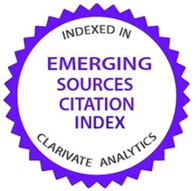Un nuevo método de procesamiento de imágenes para visualizar el patrón vascular del Cuello Uterino Humano
DOI:
https://doi.org/10.21830/19006586.77Palabras clave:
colposcopia, patrones vasculares cervicales, procesamiento de imagen digital, virus del Papiloma Humano, cáncer de cuello uterinoResumen
El cáncer del cuello uterino es un problema de salud pública en todo el mundo. El método que más se utiliza para visualizar un cuello uterino humano y para diagnosticar el cáncer de cuello uterino es la colposcopia. Cuando se altera esta estructura, la colposcopia identifica y clasifica una serie de características de las lesiones tales como tamaños, bordes, formas y patrones vasculares. Sin embargo, continúan sin respuesta algunos inconvenientes con los hallazgos obtenidos por el método clásico colposcópico. Para mejorar la calidad de los datos obtenidos con la colposcopia, se estudiaron imágenes seleccionadas del cuello uterino humano. Además, se realizó un nuevo análisis de procesamiento utilizando los métodos top-hat y umbral directo. El árbol de análisis incluyó la selección de la imagen, la eliminación de la frecuencia de la absorción de oxihemoglobina, la máscara no afilada, el tratamiento de los reflejos especulares, el enfoque del filtro y el ajuste de los niveles de intensidad. Se encontró que el método top-hat era superior para visualizar el patrón vascular del cuello uterino humano que el método de umbral directo (93,1% vs 85,1%, p <0,05). Estos hallazgos no estaban relacionados con el filtro que se utilizó. Estos resultados pueden ayudar a aumentar la probabilidad de detectar el cáncer de cuello uterino de los seres humanos en las etapas más tempranas de la enfermedad que son conocidas hasta la fecha.Descargas
Referencias bibliográficas
Arbyn, M., Castellsague, X., de Sanjosé, S., Bruni, L., Saraiya, M., Bray, F., et al. (2008). Worldwide burden of cervical cancer in 2008. Ann Oncol 22:2675-2686.
https://doi.org/10.1093/annonc/mdr015
PMid:21471563
Bappa, L.A. & Yakasai, I.A. (2013). Colposcopy: the scientific basis. Ann Afr Med 12:86-89.
https://doi.org/10.4103/1596-3519.112396
PMid:23713014
Behtash, N. & Mehrdad, N. (2006). Cervical cancer: screening and prevention. Asian Pac J Cancer Prev 7: 683-686.
PMid:17250453
Bosze, P. & Syrjanen, K. (2010) Tissue-based classification of HPV infections of the uterine cervix and vagina (mucosal HPV infections). Eur J Gynaecol Oncol 31:605-611.
PMid:21319500
Clifford, G.M., Smith, J.S., Plummer, M., Munoz, N. & Franceschi. (2003). Human papillomavirus types in invasive cervical cancer worldwide: a meta-analysis. Br J Cancer 88:63-73.
https://doi.org/10.1038/sj.bjc.6600688
PMid:12556961 PMCid:PMC2376782
Coppleson, M., Dalrymple, J.C. & Atkinson, K.H. (1993). Colposcopic differentiation of abnormalities arising in the transformation zone. Obstet Gynecol Clin North Am 20:83-110.
PMid:8392678
Durdi, G.S., Sherigar, B.Y., Dalal, A.M., Desai, B.R. & Malur, P.R. (2009). Correlation of colposcopy using Reid colposcopic index with histopathology- a prospective study. J Turk Ger Gynecol Assoc 10:205-207.
PMid:24591873 PMCid:PMC3939166
Dvir, H., Gordon, S. & Greenspan, H. (2006) Illumination correction for content analysis in uterine cervix images. In: Proceedings Conference on Computer Vision Pattern Recognition Workshop (CVPRW'06), Tel-Aviv, Israel.
https://doi.org/10.1109/cvprw.2006.96
Ferlay, J., Soerjomataram, I., Ervik, M., Dikshit, R., Eser, S., Mathers, C. et al. (2014). Cancer Incidence and Mortality Worldwide: IARC Cancer Base No. 11 (Internet) Accessed September 14.
Franco, E.L., Duarte-Franco, E. & Ferenczy, A. (2001). Cervical cancer: epidemiology, prevention and the role of human papillomavirus infection. CMAJ 164:1017-1025.
PMid:11314432 PMCid:PMC80931
Fusco, E., Padula, F., Mancini, E., Cavaliere, A. & Grubisic, G. (2008-1). History of colposcopy: a brief biography of Hinselmann. J Prenat Med 2:19-23.
PMid:22439022 PMCid:PMC3279084
Fusco, E., Padula, F., Mancini, E., Cavaliere, A., Grubisic, G. (2008-2). History of colposcopy: a brief biography of Hinselmann. J Prenat Med 2:19-23.
PMid:22439022 PMCid:PMC3279084
Guidi, A.J., Abu-Jawdeh, G., Berse, B., Jackman, R.W., Tognazzi, K., Dvorak, H.F. et al. (1995). Vascular permeability factor (vascular endothelial growth factor) expression and angiogenesis in cervical neoplasia. J Natl Cancer Inst 87:1237-1245.
https://doi.org/10.1093/jnci/87.16.1237
PMid:7563170
Kraatz, H. (1939). Farbfiltervorschaltung zur leichteren Erlernung der Kolposkopie. Zbl. Gynaek 63: 2307–2309.
Lee, Y.H. & Park, S.Y. (1990). A study of convex/concave edges and edge-enhancing operators based on the Laplacian. IEEE 37: 940-946.
Lehmann, T.M. & Palm, C. (2001). Color line search for illuminant estimation in real-world scenes. J Opt Soc Am A Opt Image Sci Vis 18:2679-2691.
https://doi.org/10.1364/JOSAA.18.002679
PMid:11688858
Lickrish, G.M. (2000). Colposcopy in the management of cervical intraepithelial neoplasia: Problems and suggestions. J Soc Obstet Gynaecol Can 22:429-434.
https://doi.org/10.1016/s0849-5831(16)31427-6
Massad, L.S., Einstein, M.H., Huh, W.K., Katki, H.A., Kinney, W.K., Schiffman, M. et al. (2013). Updated consensus guidelines for the management of abnormal cervical cancer screening tests and cancer precursors. Obstet Gynecol 121:829-846.
https://doi.org/10.1097/AOG.0b013e3182883a34
PMid:23635684
Mateu-Aragonés, J.M. (1964). Importance of the vascular picture in colposcopic exploration. classification of the vascular images. Acta Gynaecol Obstet Hisp Lusit 13:231-252.
PMid:14245998
Mateu-Aragonés, J.M. (1969). Atypical lesions of the cervix epithelium. Clinical and histological study. Acta Obstet Ginecol Hisp Lusit: 1-52.
PMid:5370772
Mateu-Aragonés, J.M. (1979). Epidemiology of endometrial cancer I. Increase in its frequency. Acta Obstet Ginecol Hisp Lusit 27:515-522.
PMid:532558
Mehlhorn, G., Kage, A., Munzenmayer, C., Benz, M., Koch, M.C., Beckmann, M.W. et al. (2012). Computer-assisted diagnosis (CAD) in colposcopy: evaluation of a pilot study. Anticancer Res 32:5221-5226.
PMid:23225419
Munoz, N., Bosch, F.X., Castellsague, X., Diaz, M., Hammouda, D. et al. (2004). Against which human papillomavirus types shall we vaccinate and screen? The international perspective. Int J Cancer 111:278-285.
https://doi.org/10.1002/ijc.20244
PMid:15197783
Munoz, N., Bosch, F.X., Herrero, R., Castellsague, X., Shah, K.V. et al. (2003). Epidemiologic classification of human papillomavirus types associated with cervical cancer. N Engl J Med 348:518-527.
https://doi.org/10.1056/NEJMoa021641
PMid:12571259
Nogueira-Rodrigues, A., Ferreira, C.G., Bergmann, A., Aguiar, de S.S., Thuler, L.C. (2014). Comparison of adenocarcinoma (ACA) and squamous cell carcinoma (SCC) of the uterine cervix in a suboptimally screened cohort: A population-based epidemiologic study of 51,842 women in Brazil. Gynecol Oncol: in press; doi: 10.1016/j.ygyno.2014.08.014.
https://doi.org/10.1016/j.ygyno.2014.08.014
Otsu, N. (1979). A Threshold Selection Method from Gray-Level Histograms. IEEE Trans Syst Man Cybern B Cybern 9: 62-66.
https://doi.org/10.1109/TSMC.1979.4310076
Peirson,L., Fitzpatrick-Lewis, D., Ciliska, D. & Warren, R. (2013). Screening for cervical cancer: a systematic review and meta-analysis. Syst Rev 2:35. Reid, R., Stanhope, C.R., Herschman, B.R., Crum, C.P. & Agronow, S.J. (1984-1). Genital warts andcervical cancer IV. A colposcopic index for differentiating subclinical papillomaviral infection from cervical intraepithelial neoplasia. Am J Obstet Gynecol 149:815-823.
Reid, R., Stanhope, C.R., Herschman, B.R., Crum, C.P. & Agronow, S.J. (1984-1). Genital warts andcervical cancer IV. A colposcopic index for differentiating subclinical papillomaviral infection from cervical intraepithelial neoplasia. Am J Obstet Gynecol 149:815-823.
Reid, R., Herschman, B.R., Crum, C.P., Fu, Y.S., Braun, L., Shah, K.V. et al. (1984-2). Genital warts and cervical cancer. V. The tissue basis of colposcopic change. Am J Obstet Gynecol 149:293-303.
https://doi.org/10.1016/0002-9378(84)90229-1
Saslow, D., Solomon, D., Lawson, H.W., Killackey, M., Kulasingam, S.L. & Cain, J.M. (2012). American Cancer Society, American Society for Colposcopy and Cervical Pathology, and American Society for Clinical Pathology screening guidelines for the prevention and early detection of cervical cancer. J Low Genit Tract Dis 16:175-204.
https://doi.org/10.1097/LGT.0b013e31824ca9d5
PMid:22418039 PMCid:PMC3915715
Schiller, W. (1933). Early diagnosis of carcinoma of the cervix. Surg Gynecol Obstet 66: 210–220.
Shamir, L., Orlov, N., Mark-Eckley, D., Macura, T.J. & Goldberg, I.G. (2008). IICB 2008: A Proposed Benchmark Suite for Biological Image Analysis. Med Biol Eng Comput 46: 943–947.
https://doi.org/10.1007/s11517-008-0380-5
PMid:18668273 PMCid:PMC2562655
Srinivasan, Y., Corona, E., Nutter, B. & Mitra, S.B. (2009). A unified model-based image analysis framework for automated detection of precancerous lesions in digitized uterine cervix images. IEEE J Select Topics Signal Processing 3: 101-111.
https://doi.org/10.1109/JSTSP.2008.2011102
Srinivasan, Y., Yang, S., Nutter, B., Mitra, S., Phillips, B. & Long, R. (2007). Challenges in automated detection of cervical intraepithelial neoplasia. Proc SPIE 6514, 65140F.
https://doi.org/10.1117/12.710051
Tomazevic, D., Likar, B. & Pernus, F. (2002). Comparative evaluation of retrospective shading correction methods. J Microsc 208:212-223.
https://doi.org/10.1046/j.1365-2818.2002.01079.x
PMid:12460452
Vizcaino, A.P., Moreno, V., Bosch, F.X., Munoz, N., Barros-Dios, X.M., Parkin, D.M. (1998). International trends in the incidence of cervical cancer: I. Adenocarcinoma and adenosquamous cell carcinomas. Int J Cancer 75:536-545.
https://doi.org/10.1002/(SICI)1097-0215(19980209)75:4<536::AID-IJC8>3.0.CO;2-U
https://doi.org/10.1002/(SICI)1097-0215(19980209)75:4<536::AID-IJC8>3.3.CO;2-E
Vlachokosta, A.A., Asvestas, P.A., Gkrozou, F., Lavasidis, L., Matsopoulos, G.K. & Paschopoulos, M. (2013). Classification of hysteroscopical images using texture and vessel descriptors. Med Biol Eng Comput. 51:859-67.
https://doi.org/10.1007/s11517-013-1058-1
PMid:23504345
Wang, S.S., Sherman, M.E., Hildesheim, A., Lacey, J.V. & Devesa, S. (2004). Cervical adenocarcin and squamous cell carcinoma incidence trends among white women and black women in the United States for 1976-2000. Cancer 100:1035-1044.
https://doi.org/10.1002/cncr.20064
PMid:14983500
Xue, Z., Antani, S., Rodney, L.R.; Jeronimo, J. & Thoma, G.R. (2007-1). Comparative Performance Analysis of Cervix ROI Extraction and Specular Reflection Removal Algorithms for Uterine Cervix Image Analysis. Proc SPIE 6512: 65124I-1-9.
Xue, Z., Antani, S., Long, L.R., Jeronimo, J. & Thoma, G.R. (2007-2). Investigating CBIR techniques for cervicographic images. AMIA Annu Symp Proc 826-830.
Xue, Z., Long, L.R., Antani, S., Neve, L., Zhu, Y. & Thoma, G.R. (2010). A unified set of analysis tools for uterine cervix image segmentation. Comput Med Imaging Graph 34:593-604.
https://doi.org/10.1016/j.compmedimag.2010.04.002
PMid:20510585 PMCid:PMC2955170
Zhu, Y., Huang, X., Wang, W., Lopresti, D., Long, G.R. & Antani, S. (2008). Balancing the Role of Priors in Multi-Observer Segmentation Evaluation. J Signal Process Syst 55:185-207.
https://doi.org/10.1007/s11265-008-0215-5
PMid:20523759 PMCid:PMC2879662
Zijlstra, W.G., Buursma, A., Meeuwsen-van der Roest, W.P. (1991). Absorption spectra of human fetal and adult oxyhemoglobin, de-oxyhemoglobin, carboxyhemoglobin, and methemoglobin. Clin Chem 37:1633-1638.
PMid:1716537
Zimmerman-Moreno, G. & Greenspan, H. (2006). Automatic detection of specular reflections in uterine cervix images. Proc. SPIE 61446E.
https://doi.org/10.1117/12.653089
Zur, H.H. (1982). Human genital cancer: synergism between two virus infections or synergism between a virus infection and initiating events? Lancet 2:1370-1372.
Descargas
Publicado
Cómo citar
Número
Sección

| Estadísticas de artículo | |
|---|---|
| Vistas de resúmenes | |
| Vistas de PDF | |
| Descargas de PDF | |
| Vistas de HTML | |
| Otras vistas | |
























